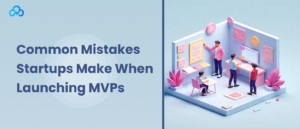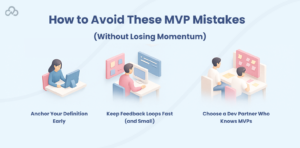Common Mistakes Startups Make When Launching MVPs

You’ve got a solid idea. Maybe even some early buzz. And you’re fired up to build something, anything, that shows what your product can do. So you dive in. Design mockups, branding, features, backend integrations. You tell yourself, “It’s just the MVP,” but six weeks later you’re still tweaking the sign-up flow and debating button colors. This happens more than founders like to admit. On paper, building a minimum viable product Agile sounds easy. You stay lean, iterate fast, validate early. But in the real world? It’s easy to overthink, overbuild, and overcommit, especially when pressure sets in.
This article isn’t here to lecture. It’s here to walk you through the honest, recurring mistakes startups make when launching MVPs, and how to avoid them. Whether you’re solo or working with an MVP development service, the goal is the same: learn fast, fail small, and build something that actually matters to users.
What an MVP Really Is, And Why Agile Changes the Game
Before we get into what’s going wrong, let’s get one thing straight. The minimal viable product definition isn’t just “a quick version of your app.” It’s not a beta. It’s not a pretty demo. And it definitely isn’t “the cheapest way to launch.”
No, it’s more like this: your MVP is the smallest, simplest version of your idea that still delivers real value to real users, and teaches you something important in the process.
When you bring Agile into the mix, that learning becomes the engine. In a minimum viable product Agile model, the MVP isn’t a destination. It’s a cycle. You build something small, ship it, learn. Then you build the next thing better.
However, that’s where most teams get tripped up. They build too much too early. They wait too long to ship. Or they forget why they’re building at all.
In Agile, your MVP should feel uncomfortable. Unfinished. You should want to apologize for it. That’s the point. It’s not supposed to be “done.” It’s supposed to be useful, for learning.
So, if you’re struggling with defining an MVP, start by asking: “What’s the absolute minimum we need to test whether this thing solves a problem?” Everything else? That can wait.
The Most Common MVP Mistakes (and Why They Happen So Often)
1. Confusing an MVP With a Full Product
This is the classic mistake. Teams build what they hope the product will eventually become, not what it needs to be right now.
They call it an MVP, but in reality, it’s version 1.0 with a logo and half the roadmap attached. And the sad part? Most users don’t even get that far.
When you’re defining an MVP, the focus should be razor-sharp. Forget the edge cases. Forget the extra features. Ask, “What’s the one thing this should do well, right now?”
In Agile terms, if it takes longer than a sprint to build and test, you’re probably doing too much.
2. Collecting Feedback Too Late (or Not At All)
Here’s another common trap: a team launches something they call “minimal,” then waits weeks, or even months, for feedback.
But here’s the truth: if feedback isn’t baked into the MVP from day one, you’ve already lost half the value. The entire minimum viable product Agile mindset is built around tight loops, build, measure, learn. Fast.
And yet, some startups treat their minimum viable product Agile like a finished product that needs applause, not critique. That hesitation to listen? It slows everything down.
Real teams put messy prototypes in front of real users, often. They adjust fast. And yes, sometimes it hurts. But that pain leads to progress.
3. Picking the Wrong MVP Development Service
It’s tempting to hire fast when the pressure’s on. But choosing the wrong partner can kill momentum just as quickly.
There are plenty of agencies and freelancers out there claiming to build MVPs. But if they don’t understand iterative cycles, rapid testing, and lean delivery, you’ll end up with something expensive, and unvalidated.
Good MVP development companies will slow you down just enough to ask better questions. They won’t say “yes” to everything. Instead, they’ll help you strip your idea down to its most testable form.
That tension? That’s what you want. Because building an minimum viable product Agile isn’t about hitting publish. It’s about hitting truth, as fast and cheaply as possible.
How to Avoid These MVP Mistakes (Without Losing Momentum)

Now that we’ve unpacked the problems, let’s talk fixes. The good news? Most MVP missteps aren’t fatal. They’re just expensive detours. If you’re paying attention and willing to rethink, you can recover, and even improve your product in the process.
Here’s what to focus on:
Anchor Your Definition Early
Start by being brutally honest when defining your MVP. Don’t let internal politics or investor pressure bloat your feature list. If a feature doesn’t directly help test your product’s core value, it’s baggage.
Try framing it like this: “If we couldn’t build this feature, would it kill the idea?” If the answer is no, cut it.
It might help to revisit the minimal viable product definition with your team, literally write it on a whiteboard. Remind everyone that this isn’t the endgame. It’s a conversation starter with your market.
Keep Feedback Loops Fast (and Small)
You don’t need thousands of users to validate your MVP. You need the right five. Start with low-effort channels: DMs, niche forums, product hunt comments. That’s enough to test assumptions.
More importantly, run your feedback sessions like sprints. Review, tweak, test again. This is the rhythm of minimum viable product Agile cycles. The tighter the loop, the faster your idea improves.
Choose a Dev Partner Who Knows MVPs
This one’s make-or-break. A generalist dev shop will build what you ask for. A real MVP development service will build what you need, even if that means pushing back.
Before hiring, ask how they define an MVP. Ask how they handle scope creep. The best MVP development companies will have real case studies, rapid timelines, and a clear process for iteration, not just design sprints and code commits.
Some agencies even offer phased MVP packages, where your version 0.1 launches in weeks, not months. That’s what you’re after.
Data-Backed Decisions: Use Analytics and Structure Your MVP Like a Pro
Startups often skip metrics in their MVPs because “it’s just a test.” But if you’re not measuring, you’re just guessing.
Here’s a snapshot from a 2023 industry study:
|
MVP Approach |
Avg. Time to Launch |
Success Rate (Post-MVP Pivot) |
|
Built in-house (no feedback) |
10–12 weeks |
17% |
|
Agile MVP w/ user testing |
4–6 weeks |
54% |
|
MVP via specialized agency |
6–8 weeks |
61% |
That gap? It’s not just speed. It’s feedback, iteration, and focus.
Also, use a lean backlog template. Agile teams that track MVP features in smaller increments (think stories, not specs) avoid overbuilding. A great MVP development service will often provide these templates, and coach your team through using them.
And yes, track KPIs. Even basic ones. Try these:
-
Time to first user interaction
-
Drop-off after onboarding
-
Feature request frequency
-
Manual workaround rate (how often users hack their way through)
You don’t need perfect analytics. You just need visibility.
Technical FAQs
1. What’s the connection between Agile and the minimum viable product approach?
The minimum viable product Agile model is all about learning fast. In Agile, your MVP is never static, it evolves sprint by sprint based on actual user behavior and feedback loops.
2. How do MVP development companies speed up the process?
They reduce decision fatigue. Specialized MVP development companies know how to trim scope, set guardrails, and launch quickly without skipping the learning phase.
3. Is defining an MVP different when using external teams?
Yes. A good MVP development service will help you refine, not just implement, your MVP. Expect them to challenge your assumptions, not just code your wishlist.
4. What’s a common misread of the minimal viable product definition?
People often assume it means a half-built version of the final product. In reality, it’s a tool to validate a specific idea, not a preview of what’s coming. Think “discovery,” not “demo.”
MVPs Aren’t About Perfection, They’re About Progress
Launching a startup is chaotic. You’re juggling ideas, assumptions, expectations, and probably not sleeping much. It’s tempting to chase polish or build out “just one more feature” before showing anything to users.
But the truth? That urge is the enemy of momentum.
If you take nothing else from this article, take this: your MVP isn’t the product. It’s a tool. A test. A shortcut to clarity. And when you pair that mindset with the structure of minimum viable product Agile practices, you give your team a real shot at staying grounded, while still moving fast.
So yes, defining an MVP is hard. It forces focus. It exposes assumptions. But that’s the whole point. You’re not building to show off, you’re building to learn. The sooner you accept that, the faster you can build something people actually want.
And whether you go solo, bring in a partner, or work with a seasoned MVP development company, remember: the goal isn’t to ship the perfect thing. It’s to ship something real, test it ruthlessly, and evolve from there.
Startups that embrace this messy, feedback-driven process? They don’t just launch, they last.
Do you like to read more educational content? Read our blogs at Cloudastra Technologies or contact us for business enquiry at Cloudastra Contact Us